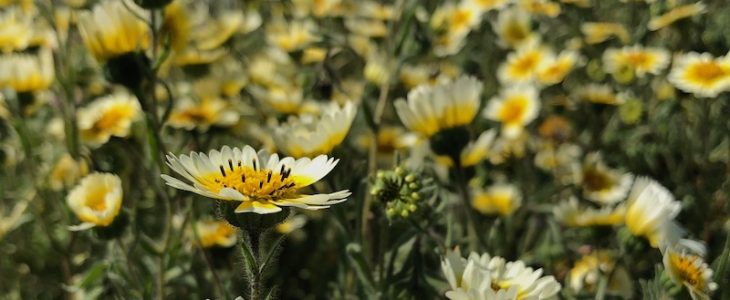
Our Annuals Are Ready!
If you haven’t seen them yet, our yearly crop of annuals is ready! This year, we’ve grown some of your favorite annual wildflowers, and some that may be new to you. There are some rare plants, some common (yet stunning) species, and much more!
From the Yorkias (formerly known as Clarkia) like the much-beloved farewell-to-spring, tidytips (Layia spp.), and baby blue eyes (Nemophila menziesii) – to the Farnsworth’s jewelflower (Streptanthus farnsworthii), calico monkeyflower (Diplacus pictus), and the desert candle (Caulanthus inflatus), there is something for every garden and every plant lover!
What are annuals, even?
Annual wildflowers are short-lived, beautiful, and fleeting bursts of color. They are fast-growing herbaceous plants that quickly produce pollen and nectar, and they generally disperse many little seeds throughout or at the end of their ephemeral lives. This shortened lifespan is an evolutionary adaptation to water availability, which we can easily observe in areas with warm climates with yearly drought periods (no annual plants exist in the polar regions or in the wet tropics!). Annuals survive the dry weather in the summer and fall, and through the cold of the winter months by existing in the form of seeds (usually*)! In this form, the plants are dormant, yet still alive. Their metabolism is slowed to nearly nothing, and they can survive for long periods of time (sometimes decades) until the right conditions present themselves again. Some plants have even gone even further to ensure higher survivorship: some will only germinate after fire. Some need a period of cold to break dormancy. In some rare cases, a percentage of seeds in the seed bank will not germinate even in the most ideal conditions until they are ten years old, as in the desert lupine species!
*In some California desert climates, the seeds will germinate in late fall or winter (whenever the first rains come), and weather the winter as an inconspicuous basal rosette. Most people won’t notice plants in this form because their leaves lay flat against the ground to maximize heat retention throughout the cold winter months.
Why are annuals important?
As many of you know, annuals are not only a colorful addition to the spring garden, but they are also critical nectar sources and host plants to spring pollinators. The intricately woven webs of life in most terrestrial ecosystems depend on pollination of flowering plants for survival (including us humans having our basic needs met). Food, shelter, and clean water – as well as our health, and sense of connection to each other and the land – are all ultimately provided thanks to the plants and their evolutionary relationships with pollinators. Animals such as native bees, beetles, butterflies, birds, and bats (and many more!) play critical roles in this mutually beneficial dance with the plants and the land, and we truly could not live without them. We can help maintain resiliency of the webs of life in which we exist by planting and tending the land with much-needed flowering plants, like the annual wildflowers.
Annuals at our Nursery
We grow annual plants in winter and spring, and they usually are ready to plant by February. Lucky for you (and the pollinators!) there are lots of annuals currently in stock at our nursery! We welcome you to check out our online inventory to read more about each species we have lovingly grown this year. You are also encouraged to come see them in person! Remember – they won’t return until 2023 after this crop is gone! For those of you still skeptical about planting such fleeting flowers, remember: in many cases, you will see these amazing plants come back year after year in your garden once you plant them, due to their prolific seed production.
More Exciting News in the Nursery!
We are honored and overjoyed to participate in growing plants for our friends at the new location of the Ohlone Cafe! We have grown and donated these plants in community, respect, and recognition that we are uninvited guests on unceded Chochenyo Ohlone Land. Living on this land and growing native California plants is a privilege and honor that we do not take lightly. Thank you to Vincent Medina and Louis Trevino for your friendship and partnership, which we hope to grow over the coming years.
As you know, we are a very small business, and if you feel moved to donate to help cover the cost of these plants, please contact Kristen Hopper (owner of Oaktown Native Plant Nursery) at oaktown@oaktownnursery.com.
Bringing back The Natives Garden Tour
Two years into the COVID-19 pandemic, we are so looking forward to the 2022 Bringing Back the Natives Garden Tour!
An online tour will be held April 16-17: Doug Tallamay will give a talk on Oaks! You will also be able to see many homes with native plant gardens via this two-day virtual event.
The in-person tour is back this year! April 30 and May 1, you will have the opportunity to visit 50 gardens! These gardens grow in Contra Costa and Alameda Counties – for the very first two-day in-person BBTNGT event ever!
Also new this year: green home features are being included!
You can volunteer, register, and find out more information this online and in-person event, including the details for CNPS discounts, plant sales and more at their website.
Take care everyone, hope to see you soon in the nursery!
Adder Schlosser